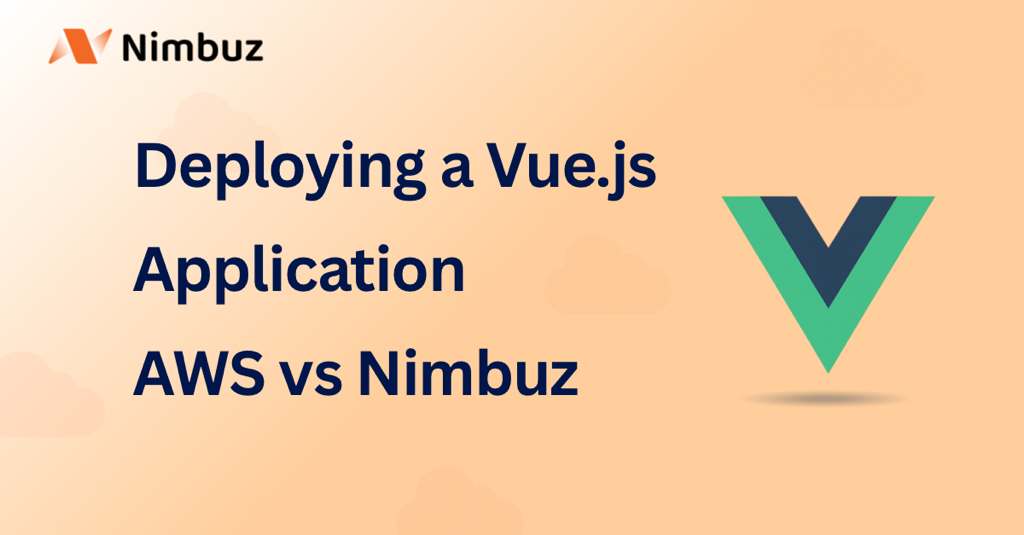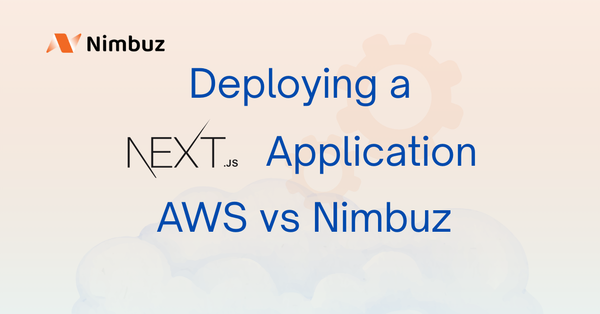Deploying a Vue.js Application on AWS vs Nimbuz

When it comes to deploying a Vue.js application in the cloud, two options stand out: AWS EC2 and Nimbuz Platform. Both are powerful, but they take very different approaches. AWS EC2 offers flexibility and control but requires a more complex, manual deployment process. In contrast, Nimbuz Platform is built for simplicity and speed, allowing you to deploy your app easily with just a few clicks.
Deploy a Vue.js Application on AWS EC2
Deploying a Vue.js application on AWS EC2 is powerful and flexible, but it requires multiple manual steps. From setting up the server to configuring HTTPS, you’ll need to run several commands and manage the environment yourself. Here’s the complete guide:
Step 1: Launch an EC2 Instance
- Sign in to your AWS Console and go to EC2.
- Click Launch Instance and configure the following:
- AMI: Ubuntu Server 22.04 LTS
- Select an instance type.
- Launch the instance and note the Public IPv4 address.
Step 2: Install Node.js and npm
On Ubuntu/Debian:
sudo apt update
# Install Node.js (includes npm)
sudo apt install nodejs npm -y
# Verify installation
node -v
npm -v
Step 3: Install PM2
PM2 helps keep your app running continuously in the background.
# Install PM2 globally
sudo npm install -g pm2
# Verify installation
pm2 -v
Step 4: Clone Your Vue.js Project
Use Git to clone your repository from GitHub, GitLab, or Bitbucket.
# Clone the repository
git clone <your-repo-url>
# Move into the project folder
cd <your-project-folder>
Step 5: Install Project Dependencies
Install all dependencies listed in package.json:
npm install
Step 6: Build the Project
For most front-end projects like Vue:
npm run buildThis will create a build folder with production-ready assets.

Step 7: Serve the Build
Using http-server (simple static server):
# Install http-server globally (if not installed)
sudo npm install -g http-server
# Serve the build folder (example for Vue/React)
http-server dist -p 8080
Step 8: Run the App with PM2
PM2 allows your app to run in the background and restart automatically if it crashes.
# Start the app using PM2pm2 start http-server --name "my-app" -- dist -p 8080
# List running PM2 processespm2 list
# Save the PM2 process list to start on system bootpm2 save
# Enable startup scriptpm2 startup

You can now access your app at http://<public-ip>:8080 (Not secure).

Serve Vue App Over HTTPS with PM2
The best practice for production is to run your app securely with HTTPS.
Additionally, we need to follow the following steps for the HTTPS connection.
The secure way is to use Nginx as a reverse proxy with HTTPS. PM2 will still run your app in the background.
Step 1: Install Nginx
sudo apt update
sudo apt install nginx -y
Step 2: Install Certbot (Let’s Encrypt)
sudo apt install certbot python3-certbot-nginx -yStep 3: Configure Nginx
Step 4: Obtain SSL Certificate
sudo certbot --nginx -d yourdomain.com -d www.yourdomain.com
Step 5: Run App with PM2
pm2 start http-server --name "my-app" -- dist -p 8080
pm2 save
Your app is now securely accessible at https://yourdomain.com
Deploy a Vue.js Application on Nimbuz Platform
With Nimbuz, deploying a Vue.js app is simple, fast, and completely UI-driven. No commands, no server setup, no headaches.
Sign up or log in to Nimbuz platform
Here’s a simple, step-by-step guide to get your app running on Nimbuz:
Step 1: Go to Deployments
- Log in or sign up on Nimbuz Platform.
- Navigate to the Deployments section.
- Choose your deployment type:
- Connect Your Code Repository: GitHub or GitLab → Connect account → Pick repo and branch.
- Upload Zip/Tar File: Just upload your code.
- Configure the app port and instance type.
- Let Nimbuz handle the deployment automatically.

Step 2: Review & Deploy
- Double-check your settings.
- Click Submit - Nimbuz provisions the environment, deploys your app, and it’s live instantly.

Step 3: Monitor Your App
- View logs, status, and recent releases directly in the UI.
- No SSH or terminal required.

Step 4: Access Your App
- Go to the Networking tab → Click Generate Domain.
- Your app is automatically served with HTTPS.
- Optionally, map a custom domain.


Hosting & Endpoint Setup Compared: AWS vs Nimbuz
When it comes to deploying and hosting a Vue.js application, both AWS EC2 and Nimbuz Platform can get your app online - but the experience is very different.
AWS (EC2):
- Developers must configure hosting manually, including setting up a public IP, domain, load balancer, and routing rules
- SSL setup requires additional steps (such as generating an ACM certificate and binding it to the load balancer).
- You get flexibility, but at the cost of time and complexity.
Result: Time-consuming setup with a higher chance of misconfiguration.
In short: AWS is powerful and flexible, but requires significant manual effort.
Nimbuz Platform:
Nimbuz simplifies the entire hosting process - no terminal commands or manual configure
- When you deploy an app, Nimbuz automatically generates a public endpoint (URL).
- You can enable hosting directly from the dashboard - no need for SSH or load balancers.
- SSL (HTTPS) is enabled by default or can be toggled on with a single click - no certificate setup required.
Result: Zero-effort hosting and instant internet access for your application.
In short: Nimbuz is plug-and-play - deploy, host, and go live in minutes.
Simplifying Vue.js Deployment: Nimbuz Platform vs AWS EC2
| Feature | AWS EC2 | Nimbuz Platform |
|---|---|---|
| Deployment | Manual setup via SSH & CLI Install Node.js, Nginx, and run npm install, pm2 start |
1-click deploy from GitHub, GitLab, or Zip Nimbuz auto-handles runtime & build |
| Setup Time | ⏳ ~30-45 mins | ⚡ ~2-3 mins (automated) |
| Server & SSL | Manual config for Node.js, Nginx and Certbot | Auto-configured runtime & built-in HTTPS |
| Monitoring | Setup PM2 / CloudWatch manually | Built-in log viewer & dashboard |
| Scaling | Handled manually (PM2 or AWS Auto Scaling) | Auto-managed by platform |
| Ease of Use | Requires Linux & AWS knowledge | Beginner-friendly UI, no commands |
| Cost | Pay separately for EC2 instance, storage, and SSL. Very high cost with fixed package. | Pay only for the Nimbuz plan - all infrastructure included. Low cost, 40-50% cheaper than AWS. |
| Access URL | http://<IP> or https://domain.com |
https://app.nimbuz.tech or custom domain |
| Conclusion | Flexibility + Complexity + High Cost | Simplicity + Speed + Low Cost |
If you’re deploying an application with simple infrastructure needs and just want to get your app online quickly, the Nimbuz Platform is the best choice for ease of use.





